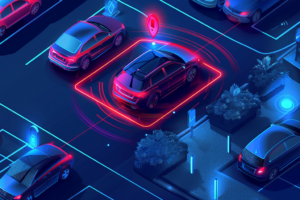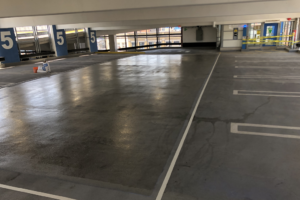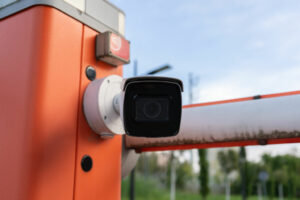Simon Fraser University’s experience implementing a new parking revenue stream.
By David Agosti
Simon Fraser University’s (SFU) main campus is located in Burnaby BC. SFU has over 5,000 parking spaces and EV Chargers has been part of their parking supply since 2012. Starting in 2021 (post-COVID) SFU has been expanding their EV Charging network in order to provide a service to customers, assist governments in their EV Charging goals, and provide an additional revenue source to the University.
Some EV Charging Basics
As the world of EV Charging evolves it is helpful to understand some of the basic terminology:
- Port – the part of the EV Charger that supplies power to the electric vehicle via a cable and charging head. Some EV Chargers have one port (can charge 1 car), and some have two.
- Level 1 Charger – slowest form of charging utilizing a 110V outlet. Normally to use a Level 1 charger the driver needs their own cable and charging head that was supplied with the car.
- Level 2 Charger – a mid-speed form of charging using AC power varying from 7KWH to 19KWH depending on model. Most Level 2 chargers have 2 ports.
- DCFC (Level 3) Charger – the fastest form of charging using DC power varying from 50KWH – 350KWH depending on model. DCFC’s fill an EV batter to approx. 90% charge after which they provide a trickle charge so as not to damage the battery.
- KWH – Kilowatt-Hour – EV Charger speeds as well as EV battery capacity are measured in KWH.
- LCFS – Low Carbon Fuel Standard – in BC (and some US States) a program that aims to reduce the carbon intensity of transportation fuels. Clean fuel…
By Giuseppina Alfarano
It is no secret that with time the world is changing right before us. Modes of transportation have evolved from once on foot, to horses and wagons, to engine-powered vehicles. Early vehicles started with basic automation and will soon progress to full automation driving.
Automated vehicles are no longer science fiction and have become the future and they can provide significant benefits in parking safety. Engineers will need to accommodate change through the new design and construction in relation to the Canadian parking industry.
Think of a time there was an amazing sale happening in the mall: this could have been Boxing Day or Black Friday. Imagine you are excited to get to the mall to save on these deals and you are faced with no parking spaces available. You’re circling around and around in the parking lot trying to find a parking space, but there is not one spot to be found. Once you find parking, you might have trouble parking, whether this is reversing, frontward parking or parallel parking. Then, before you can even get inside to see the great deals, you must find a parking machine to pay for parking. All these factors regarding parking are postponing you from getting to the sale.
Engineers can help make parking an easy, hassle-free experience allowing parkers to reach their destination quickly and efficiently. The implementation of autonomous vehicles allows this to become a reality. This lets users not to have to think twice on any aspect of parking.
Different kinds of engineers have separate roles in the design of autonomous vehicles to benefit the parking industry. Engineers assist in the creation of the automated parking system. This would require automation and robotics: implementing cameras, sensors, and robotics systems to locate…
5 best practices for maximizing the service life of your traffic deck coating
By Bryant Bortolotto-Freeman
If your building includes a parkade, chances are you’ve witnessed the wear and tear that comes from steady usage and exposure to moisture and contaminants like road salts. Even if the parking area is located indoors, the traffic deck coating (TDC) used to protect concrete surfaces will deteriorate over time, reducing its ability to effectively do its job.
“Traffic deck coating plays a key role in preserving concrete’s structural integrity, so it’s important to ensure it performs as intended,” said Bryant Bortolotto-Freeman, Engineer-in-Training at RJC Engineers. “By understanding the causes of concrete deterioration and following certain best practices to maximize your TDC, costly repairs to your concrete may be averted.”
What is Traffic Deck Coating?
A TDC is a multi-coat system formulated to protect concrete structures and structural elements from contact with moisture and contaminants. Typically, they are made up of a primer (polyurethane or epoxy-based), a basecoat, and a topcoat that work together to provide waterproofing protection, traction enhancements, wayfinding and light reflection in parkades and other concrete enclosures. Although usage of TDCs is widespread in North American, Bortolotto-Freeman has seen all-too often what happens when maintenance is ignored, or improper application creates weaknesses in the system. Common failures include debonding of the coating from the underlying substrate (or between the layers, cracks and scrapes letting in moisture, and surface damage from abrasion due to wheel racking and traffic exposure.
To prevent a failure and prolong the service life of your TDC, Bortolotto-Freeman recommends the following 5 Layers of Success:
Layer 1 – Surface Prep
Thorough surface preparation is crucial for a successful TDC installation, whether it’s brand- new concrete or an existing slab undergoing…
By Adamo Donatucci
In the parking and mobility industry, technology is pivotal in shaping its future. Across the globe, certain nations are at the forefront, strategically embracing advancements such as autonomous vehicles, micromobility solutions, intermodal applications, and shared zero-emission initiatives.
Below is a comprehensive exploration of various country policies, exploring the complex process of technological adaptation and their concerted efforts toward achieving ambitious zero-emission goals.
1. Autonomous Vehicles — A prominent force at the forefront of the automotive industry.
Undoubtedly, autonomous vehicles (AVs) have become a focal point in the mobility industry in recent years. According to a recent study by the global management consulting firm McKinsey & Company, passenger car advanced driver-assistance systems and autonomous-driving (AD) systems could generate $300 to $400 billion in revenue by 2035. Level 4 high-driving automation is anticipated to contribute $170 to $230 billion, accounting for approximately 57% of the dominant vehicle type in sales. Overall, the expectation is that 12% of new passenger cars sold by 2035 will incorporate Level 3 and 4 autonomous technologies, with 37% featuring advanced AD technologies.
For years, global car manufacturers, particularly in the United States and Europe, have promised a future of self-driving vehicles. However, recent trends suggest China is poised to lead the global shared AVs market. Research indicates that the top 5 regions in China collectively command 51.3% of the total autonomous mobility market. At the same time, the United States holds 47.5%, and Europe (including the United Kingdom, France, Spain, and Germany) accounts for 62.3%.
Government support is a crucial factor in fostering AV adaptation. Since 2020, over $48 billion has been invested in AVs, with the US leading in investments in 2020 ($7.3 billion) and 2021 ($11.3 billion). China surpassed the US by investing $4.7…
By Randy Topolniski
In 2017, the Province of Manitoba passed The Local Vehicles for Hire Act, which dissolved the Manitoba Taxicab Board, repealed The Taxicab Act, and associated regulations, and transferred oversight of vehicle for hire (VFH) regulation to the municipalities. The Winnipeg Parking Authority (WPA)- a special operating agency of the City of Winnipeg- assumed responsibility for regulating the VFH industry, with Grant Heather managing this new business line. In December 2017, the City enacted a new Vehicles for Hire By-law that streamlined and modernized VFH regulations, and the newly formed VFH division opened its doors in 2018.
2023 Global Regulator of the Year
For the past several years, the WPA has been a member of the International Association of Transportation Regulators (IATR), a non-profit organization dedicated to sharing best practices in the licensing and regulation of for-hire ground transportation services. In recognition of their efforts to improve VFH service in Winnipeg, Grant Heather and the WPA’s VFH division was recently named the IATR’s 2023 Global Regulator of the Year. Winnipeg is only the second Canadian city ever to receive the IATR’s Global Regulator of the Year award, joining other recent winners including Montreal, Los Angeles, London, Chicago, and New York. Said Grant Heather, “This award is especially gratifying considering we have only been around for five years. It speaks to the incredible contributions our entire team has made in that short time.”
Over the course of those five years, the WPA’s VFH division has undertaken a number of initiatives to improve driver and passenger safety (winnipeg.ca/vehiclesforhire/safety-security.stm), service accessibility, and the integration of for-hire travel options into Winnipeg’s transportation system. Early examples include the addition of audio capabilities to the onboard camera systems required in each taxi and a rigorous vehicle safety program…
By Vitaly Vinogradov
We all hate traveling to the airport; that’s a fact of life. Half the problem is the parking situation. Airport parking can be a hassle, expensive, and unsafe. And despite the digital revolution and the rapid push to automation, airport parking has remained largely unchanged. It badly needs a revamp.
With on-site parking facilities being overly congested and often archaic, offsite airport parking lots have emerged as a viable alternative. Though off-site has earned a negative reputation for safety, I think that is unfair. In recent years, off-site lots have increasingly adopted and implemented novel security tools embedded with next-generation AI technologies that keep vehicles safer and more secure. Conversely, on-site lots have largely fallen behind the technical curve due to the overhead costs involved.
Off-site parking lots have lower operating expenses, so they tend to charge lower rates, making them a more cost-effective option for travelers. The lower overhead costs also allow offsite lot operators to implement new technologies and experiment a bit. Yet offsite also poses challenges logistically, such as travelers getting from the lot to the airport and back. Many travelers are thus still willing to pay more for the convenience of on-site parking, despite the general lack of technical sophistication.
Regardless of your personal preferences, its clear technology has been rapidly advancing at off-site parking lots, which are attempting to compete with official airport parking. Let’s look into the how and why.
Busting the Myth
Many travelers assume on-site airport parking is safer because it’s an official service offered by the airport. However, on-site lots tend to sprawl across large swaths of land, and they can be difficult for airports to monitor and manage. Moreover, they’re typically not cordoned off from the…
By Bill Franklin
The Electric Vehicle revolution is everywhere, featured in news headlines, YouTube EV Road reviews, endlessly analyzed in business publications, pursued and promoted by politicians. This amazing sea change after 120 years of the internal combustion engine (ICE) has inspired city councils to mandate fleet services switch to electric. Alas, this is where the rubber hits the road, and reality and reason collide with aspirations.
The City of Saskatoon’s Parking management is a client of our company and approached us to evaluate the feasibility of switching their LPR vehicles to all electric. We already had installed autoChalk LPR on electric vehicles elsewhere and it had minimal impact. But cold temperatures significantly impact battery performance and increase a vehicle’s energy consumption. We were intrigued to join them as part of
their analysis.
Since the internal combustion engine has been around for over a century, engineers and manufacturers have improved both the engines and vehicles to face extreme cold. At times Saskatoon dips to minus 50°C yet their diesel- and gas-powered vehicles, trucks, tractors, snowplows, SUVs are out in the field doing their job.
What then should be expected of an electric vehicle?
• Operates in temperatures from -50°C to +40°C.
• Runs all day on a tank of fuel or an electric charge.
• Starts up reliability every morning and runs all day, month after month.
• Is comfortable to drive, has storage space, can have equipment mounted to it (e.g., License Plate Recognition equipment).
• Fleet services can maintain it and get parts.
• Purchase price of CAD$40,000 or less for an EV SUV.
• Maintenance cost is reasonable.
• Infrastructure cost is affordable.
Tesla and Nissan have been producing electric cars and SUVs for fifteen years and Toyota has sold the very successful Prius hybrid…
From code changes to fire safety, now’s the time to plan ahead
By Frank Cavaliere
In the coming decade, car manufacturers in Canada will be subject to penalties for not producing and selling the right quota of electric vehicles (EV), contributing to a rapid rise in EV ownership. Given electric-powered vehicles are heavier than their gas-fuelled counterparts, there’s a good chance Building Code requirements will be changing in the near-term to address design loads for parkades, particularly as more electric pick-up trucks and SUVs begin flooding the market.
“Currently, it’s the owner’s decision whether or not to upgrade their parkades,” says Frank Cavaliere, Managing Principal at RJC Engineers. “But new parkades being designed and constructed should, prudently, be engineered to support more load than the Code requires to provide capacity for future vehicles,” he says. “We know what’s coming—and that’s larger, heavier models, including…dare I say…electric Hummers.”
The current recommendations for what are deemed by the industry to be acceptable floor coatings in parkades were based on lighter passenger car vehicles with pneumatic or “air-inflated” tires. EVs shall be heaver and they shall impose more wear on the floor coatings. These floor coatings are important because they are protecting the floor structure from corrosion.
Not only are EV vehicles forecast to be heavier, but the tire types are forecast to be changing to non-pneumatic. Non-pneumatic tires would resemble a wire-mesh frame-type and be not air-filled like. These would be like those used for the Moon Buggy driven by the Astronauts. Today these tires are quite expensive and not yet market competitive. Much research needs to be done however they shall require much less maintenance (without getting a “flat”) while they impose much higher stresses on the floor…
By Bill Franklin
Our company, Tannery Creek Systems, has been making License Plate Recognition equipment since 2007. In the sixteen years growing our company across North America, one of the most common and interesting topics that our clients raise is license plate recognition (LPR). How does it work? Can I use it for permits? Do you sell this data? What is the rate of recognition?
This article was inspired by the LPR panel that I moderated at this year’s Canadian Parking Association conference and tradeshow. The set of questions raised by or to the audience is the springboard to this article. I have added additional questions that our clients have asked us. In this question-and-answer format, you may discover a deeper understanding of LPR.
What is LPR?
License Plate Recognition (LPR) is a specialized Optical Character Recognition (OCR) system. It requires a camera and computer to extract the characters and try to make sense of them. LPR, among other names, is also known as:
- Automatic Number Plate Recognition (ANPR)
- Automatic License Plate Recognition (ALPR)
- Automatic Vehicle Identification (AVI)
- Plate scanner
LPR was originally developed at Scotland Yard in the UK and began operation in 1978, so it has been around for a good many years.
How does it work?
Typically, a camera captures 20 frames per second (or more) and these frames are analyzed for the presence of a rectangular surface with digits, i.e., a license plate. The analysis can be in the camera that has a sophisticated microprocessor, a graphics processing unit (GPU) or processed in the Cloud which will employ essentially the same thing, i.e., a GPU. Two competing systems perform LPR: font-based recognition versus the newer artificial intelligence (AI) also called machine learning based systems.
By Brian Wolff
Over the past decade, municipal parking has become extremely data centric. As municipal parking administrators have come to rely increasingly on technology to improve the parking experience, they’ve discovered that these same tools can provide valuable operational data that can be used to manage parkades more efficiently and effectively.
PARCS systems, parking guidance, LPR, and mobile payment apps are wonderful management tools that provide important utilization data. Need to know how full your lot or parkade is, and when it tends to be most full? These technologies can tell you, often in real-time on any device. Want to know what types of parkers are using your parkade, an automated permitting program tied to your PARCS system can tell you that.
It’s obvious why these types of data are so valuable. Benchmarking is an essential element of any parking management program. If you understand your parking trends you can make sensible decisions about how to manage your parking programs. It’s why so many parking owners and operators rely on their PARCS and guidance tools for data.
Ask the Customer
But if you are focused solely on utilization data, you are only getting half the story; and you may not be getting the most important half. As important as it is to know who is parking in your facility, and when, it’s even more important to know how their experience was. Did they have trouble getting in and out of the parkade or lot? Did their payment go smoothly? Did gates and ticket machines work as expected? These are essential issues if you want to earn repeat business from parkers.
The most obvious way to get this information is by surveying customers. Hearing about parkers’ experiences straight from their own mouths is the best way to see how…













